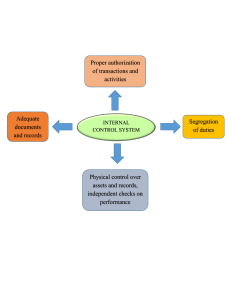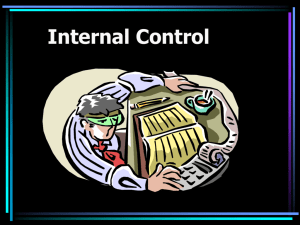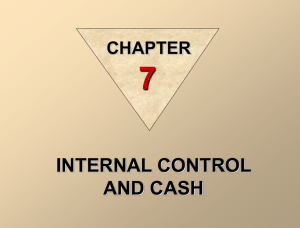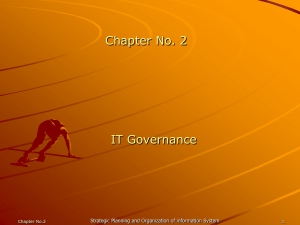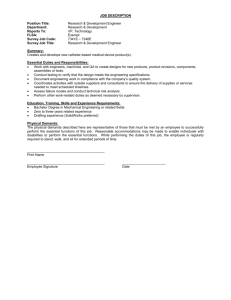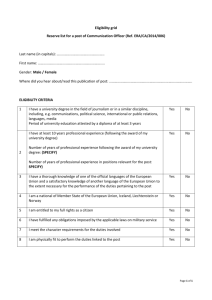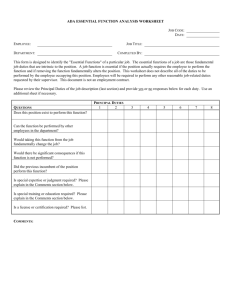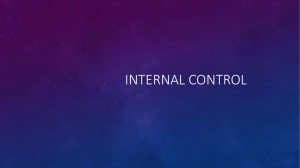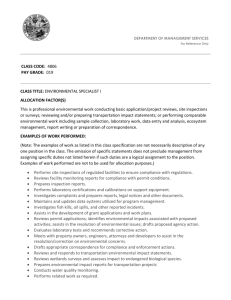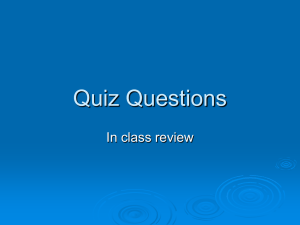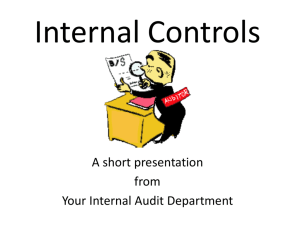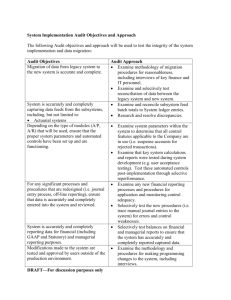Internal Control
advertisement
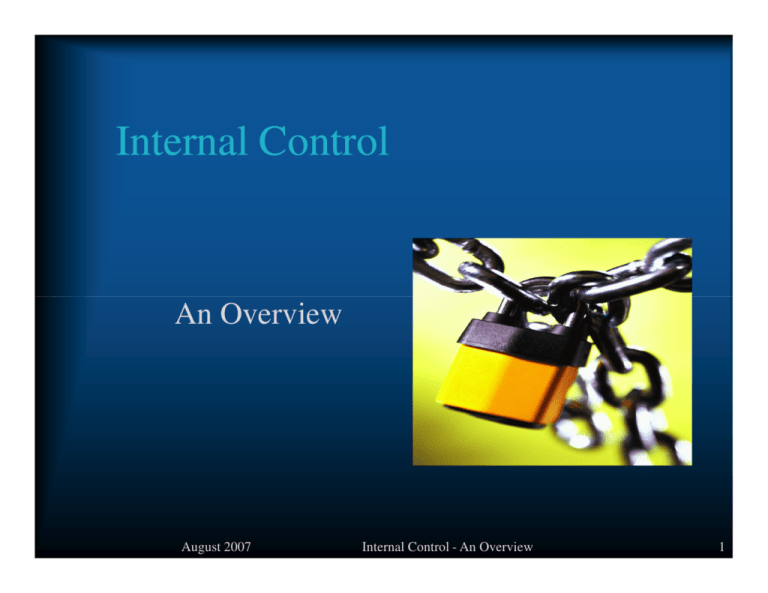
Internal Control An Overview August 2007 Internal Control - An Overview 1 Internal Control? August 2007 Internal Control - An Overview 2 Management’s Role ♦ Management’s role is to provide leadership that the organization needs to achieve its goal and objectives. ♦ Internal control is a technique used by managers to help an organization achieve these objectives. August 2007 Internal Control - An Overview 3 Four Basic Functions of Management Planning Organizing Directing Controlling Internal control is this 4th function. Adequate internal controls allow managers to delegate responsibilities with reasonable assurance that what they expect to happen, actually does. Managers must develop internal controls for each activity for which they are responsible. August 2007 Internal Control - An Overview 4 Five notable concepts: • Internal control is a process integrated with all other processes within an agency. • Internal control is established, maintained, and monitored by people at all levels within an agency. • Internal control increases the possibility of an agency achieving its strategic goals and objectives. • Internal control must be cost effective and cost of implementation should not exceed the benefits derived from having the control in place. • System of internal control in an organization is the responsibility of all employees, from management who design, implement, and maintain controls to staff that execute various control activities. August 2007 Internal Control - An Overview 5 Why do we need Internal Controls? To Provide Accountability . . . – Public sector managers are responsible for managing the resources entrusted to them to carry out government programs. August 2007 . . . And to Encourage Sound Management Practices – Internal controls coordinate a department’s policies and procedures to safeguard its assets, check accuracy and reliability of data, promote operational efficiency, and encourage adherence to sound management practices. Internal Control - An Overview 6 3 Categories of Assurance Provided by Internal Control Effectiveness and efficiency of operations; Reliability of financial reporting; and, Compliance with applicable laws and regulations. August 2007 Internal Control - An Overview 7 Four Basic Types of Controls ♦ Preventative ♦ Detective ♦ Corrective ♦ Control point is a point in the process where an error or irregularity is likely to occur, creating a need for control. ♦ Compensating August 2007 Internal Control - An Overview 8 Five Specific Control Methods 1. Organizational Control establishes the framework within which the company conducts its various activities. The five types are as follows: August 2007 Purpose, Authority, and Responsibility Organizational Structure Decision Authority Job Descriptions Segregation of Duties Internal Control - An Overview 9 Five Specific Control Methods (cont.) 2. Operational Controls dictate the manner in which the organization performs its various activities and conducts its affairs. The seven types are as follows: August 2007 Planning Budgeting Accounting and Information Systems Documentation Authorization Policies and Procedures Orderliness Internal Control - An Overview 10 Five Specific Control Methods (cont.) 3. Personnel Controls help ensure suitable employee performance.The three types are as follows: Recruiting and Selection of Suitable Personnel Orientation, Training, and Development Supervision August 2007 Internal Control - An Overview 11 Five Specific Control Methods (cont.) 4. Periodic Review help organizations assess the progress and performance of their employees, operations, and programs.The three types are as follows: Reviews of Individual Employees Internal Review of Operations and Programs External Reviews August 2007 Internal Control - An Overview 12 Five Specific Control Methods (cont.) 5. Facilities and Equipment Suitable facilities help build effective & efficient operations while protecting the organization’s assets Unsuitable facilities and equipment jeopardize both the operations and the assets August 2007 Internal Control - An Overview 13 What is Risk? Risk is the probability of an event or action having an adverse effect on your organization. ♦ Examples of Risk include the risk that: – Operations are not operating effectively/efficiently; – Financial and operating reports are unreliable; – Assets are not adequately safeguarded against loss; – Operations are not in compliance with laws, rules, & regulations; and, – Unit’s missions or goals are not achieved. August 2007 Internal Control - An Overview 14 Affects of Uncontrolled Risk Uncontrolled risk can severely handicap an organization and eventually result in its failure. Consequences are as follows: • • • • • Resources are acquired or used inefficiently or ineffectively resulting in shortages of funds or failure of a unit to meet goals. Loss of assets due to theft or unintentional errors. Unreliable financial and operational reports, resulting in poor decisionmaking by management. Non-compliance with laws, rules, or regulations resulting in financial penalties or damage to the reputation of the unit Customer dissatisfaction due to ineffective operations resulting in loss of customers or negative publicity. August 2007 Internal Control - An Overview 15 What factors affect risk? ♦ Many factors affect the significance of a particular risk. Risk is controlled by reducing or otherwise impacting these factors. Factors include: – Ethical Climate maintained by management; – Degree of computerization; – Adequacy and effectiveness of the System of Internal Control; and, – Degree of Regulation. August 2007 Internal Control - An Overview 16 Biggest threats to the Internal Control Structure Management Override A well-designed control system, if set aside at management’s discretion, can be equivalent to no control in terms of risk. Access to Assets The best way to safeguard assets is to control access to them. Substance over Form Controls may appear to be well-designed and still lack substance. Conflicts of Interest When an employee’s loyalties are divided there is a distinct risk that the employee will chose a course of action detrimental to the organization. Failure to Anticipate Certain Risks Management may fail to anticipate certain risks, and thus fail to design and implement appropriate controls. Collusion August 2007 Two or more employees may agree to circumvent internal controls. Internal Control - An Overview 17 Management’s Responsibilities & Classification of Management Controls ♦ Classification of Management Controls: ♦ Management’s Responsibilities: – Management is responsible for establishing effective management controls. – Change inherent to government units increases the need for effective management controls. August 2007 – Includes the controls relevant to Program Operations, Validity and Reliability of Data, Compliance with Laws and Regulations, and Safeguarding resources. Internal Control - An Overview 18 Segregation Of Duties The fundamental premise of segregated duties is . . . that an individual or small group of individuals should not be in a position to initiate, approve, undertake, and review the same action. August 2007 Internal Control - An Overview 19 Examples of Activities to be Properly Segregated Personnel & payroll activities Revenue activities Check writing activities August 2007 Other expenditure activities Inventories Internal Control - An Overview 20 Segregation of the Accounting Function • • • • Authorization - Authorization is normally performed by a supervisor, office manager, or department head. Examples include approving voids and refunds, approving budget transfers, approving time sheets and leave requests, and approving the disposition of inventory. Record Keeping - Record keeping is normally performed by administrative employees. Examples include preparing travel vouchers, maintaining expenditure files or revenue records, maintaining payroll files, and maintaining inventory records. Asset Custody - Asset custody duties are performed by any individual having access to or control over any physical asset. Examples include access to any funds through collection of funds or processing of payments, maintaining inventories, access to safes, lock boxes, etc. Reconciliation - The reconciliation function is the process of reviewing and verifying transactions to ensure they are valid, properly authorized, and recorded on a timely basis. Examples include comparing billing documents to billing summaries, collections to deposits, etc. August 2007 Internal Control - An Overview 21 Mitigating Controls ♦ Mitigating controls are additional control procedures placed in a system to help reduce the risks associated with a failure to adequately segregate incompatible functions. ♦ Most mitigating controls consist of detailed reviews of transactions, after-the-fact approvals, and period surprise checks. August 2007 Internal Control - An Overview 22 Questions? Thank you! August 2007 Internal Control - An Overview 23
